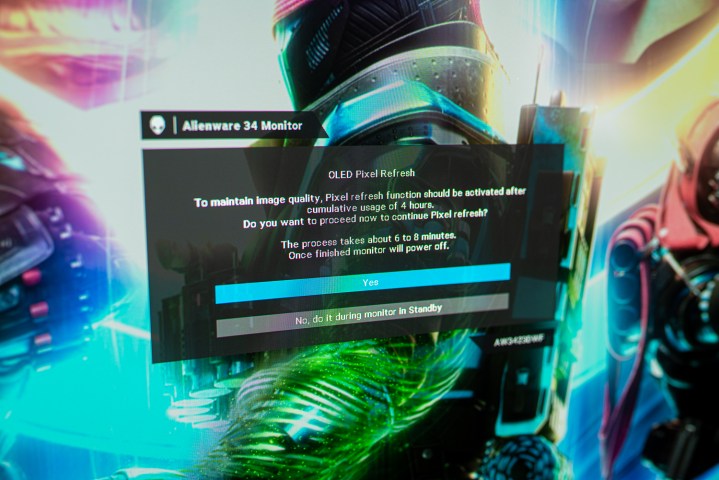
The Steam Deck OLED is starting to show burn-in issues.
YouTuber Wulff Den released a report on the Steam Deck OLED, showing it suffered from OLED burn-in after 1,500 hours of screen time. This isn’t the first time we’ve seen a torture test on the Steam Deck OLED, but Wulff Den’s experiment is particularly potent. The YouTuber was among the only people to put the Nintendo Switch OLED to the test on the burn-in front, and the consistent updates over the course of two years remain some of the most-viewed videos on the channel.
The Steam Deck OLED showed burn-in issues much faster than the Nintendo Switch OLED. It took just over 63 days for the Steam Deck OLED to develop burn-in based on Wulff Den’s testing, and that’s a generous time frame. YouTuber The Phawx tested the handheld shortly after it released with the maximum HDR brightness and found burn-in after just 750 hours.
Before you throw your Steam Deck out, though, keep in mind that these are accelerated stress tests. Even if you run your Steam Deck at maximum brightness, it won’t develop burn-in after 750 hours if you’re putting a variety of different content on the screen. These time frames are if you leave a static image on the screen, 24 hours a day, 7 days a week.
Still, Wulff Den’s testing reveals some critical safeguards that are missing from the Steam Deck OLED to prevent or minimize burn-in. Most OLED screens come with a set of features that keep burn-in at bay for as long as possible. Monitors like the Alienware 34 QD-OLED have short-term and long-term pixel cleaning features, for example, which adjust the light output of individual pixels so the screen looks consistent. Other displays, such as the recent Asus ROG PG34WCDM, even include static element dimming. This takes static content on the screen and dims it to prevent burn-in.
Similarly, OLED TVs usually include a form of pixel shifting. This is where static elements will slowly shift back and forth on neighboring pixels so there isn’t too much stress put on one set of pixels. You can’t see this happening, but it helps keep the screen looking fresh. With a set of mitigation features, an OLED display can last you years without issues.

As some OLED experts have told us, the technology has a limited shelf life. At some point, the organic material used for OLED will wear out, manifesting as either burn-in or vastly reduced brightness. These features extend the life span as long as possible, however, and hopefully that’s long enough where the device is far past its usefulness.
The problem is that the Steam Deck OLED doesn’t have any of these features. Wulff Den reached out to Valve to confirm, and a representative said that “we aren’t aware of users having issues under normal use.” In fairness to Valve, the Nintendo Switch OLED, the only other handheld with an OLED display, also doesn’t include these features.
So, why did the Steam Deck OLED burn-in show much faster? Valve’s handheld is significantly brighter. In fact, it can reach peak brightness of 1,000 nits in HDR, which is on the same level as a proper OLED gaming monitor. The Switch doesn’t support HDR, and in SDR, it tops out below 400 nits.

Brightness greatly increases how quickly burn-in occurs. The brighter you run the organic material, the more strain you put on it, and the faster it degrades. That’s why the Steam Deck OLED deteriorates so much faster than the Nintendo Switch OLED in these kinds of stress tests. The screen just gets a lot brighter.
In fairness to the Steam Deck OLED, you probably won’t run it at maximum brightness at all times. There’s also a dynamic brightness option built into the device that will adjust the screen based on ambient lighting. The risk of burn-in is greater on the Steam Deck OLED compared to something like the Nintendo Switch OLED, but that’s because Valve’s handheld is capable of more.
The wrench in these cogs is Valve’s warranty. Valve offers a one-year limited warranty on the Steam Deck OLED, which is typical of most electronics. This warranty covers the screen under normal use, but you’re unlikely to see burn-in within the first year of owning the device. That’s why we’re seeing most major monitor brands like Alienware, MSI, Asus, Gigabyte, and LG update their warranties on OLED display to two or even three years.

I don’t want to stir up fear about the Steam Deck OLED. It’s probably my favorite gaming device due to its immense flexibility, solid performance and battery life, and of course, the beautiful OLED display. I’m not worried about my Steam Deck OLED developing burn-in, and if you own one, it’s not something you should lose sleep over, either.
That doesn’t change the fact that the protections against burn-in aren’t enough on the Steam Deck OLED. The screen is capable of HDR and searing brightness, driving up the risk of burn-in in a short period of time if you run the screen at full tilt. Some mitigation features, combined with a longer warranty for the screen, at least gives some peace of mind for what is still a very young category of device.
Editors’ Recommendations





